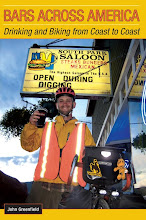
View from Loyola Beach's pier
by John Greenfield
[This article also runs in the current issue of
Momentum magazine, www.momentumplanet.com.]
“Rogers Park is universal,” says Wayne Johnson, an army vet who rides a battle-scarred mountain bike to window washing and janitorial gigs around Chicago’s northeastern-most neighborhood. “It’s cool - people of all different nationalities are here. I work with Mexicans, Pakistanis, Haitians and Koreans.”

Wayne Johnson
This cosmopolitan mix, plus Loyola University, help make the area a home for progressive politics, reflected in its many community-oriented and eco-friendly businesses, plus a burgeoning bike scene. Throw in a gaggle of serene beaches, unspoiled by Lake Shore Drive, and there’s lots of reasons to pedal up to the ‘hood.
A good first stop is the Recyclery, a community cycle center which opened last year at 7628 N. Paulina. Their FreeCyclery program donates bikes to clients of homeless shelters and immigrant advocacy organizations. “Biking’s not just a hip or environmental thing for these people,” says volunteer Jesse Miller. “It’s cheap, fast way to get around for folks who can’t afford the CTA,”

Frolian Landeros at the Recyclery
The Recyclery was a helpful port-of-entry for Tucson resident Lauren Frisk after she pedaled from Arizona to Chicago via Florida with her boyfriend Jared Votel last fall and decided to settle in Rogers Park for a spell. Frisk began volunteering at the center and board member Sharlyn Grace soon found her an apprenticeship at Roberts Cycle, 7054 N. Clark, the neighborhood’s only bike shop.
Roberts carries new bikes by Raleigh and Diamondback plus vintage Schwinn cruisers and Bianchi and Mercier road bikes. Owner Richard Bonomo and head mechanic Chris Petersen have wrenched at the shop since the early ‘70s. “Nowadays everybody wants to sell you new, new, new and nobody wants to fix anything,” Bonomo says. “But we still do repairs on three-speed hubs and coaster brakes. Income in Rogers Park is not that great, so we don’t have the luxury of just selling people new parts.”

Richard Bonomo
Loyola University is another center for cycling. Volunteers from the Loyola Bike Club, an advocacy and social riding group provide free repairs for students and community members.
Last year club leader Tony Giron established a bike sharing service, allowing students to check out refurbished cycles and helmets for free. This year rental company Bike and Roll donated 30 B-cycle commuter bikes, valued at $30,000. Similar to the cycles used in European automated rental systems, these sleek rides feature full fenders, generator lights and three-speed hubs.

Tony Giron
Giron says the best thing about cycling in Rogers Park is proximity to the Lakefront Trail, a few blocks south of campus. The North Shore Channel Trail, an undulating greenway with wacky public art, lies just west of the neighborhood. And at Loyola Beach, a bike path runs for several blocks alongside a mural-covered wall.

Sculpture on the North Shore Channel Trail
But Giron feels that the area still doesn’t have its fair share of bikeways. “Especially near the lake,” he says. “People have to use back street routes and alleys to get around since Sheridan Road is so hard to ride on.”
He supports Friends of the Parks’ plan to extend the Lakefront Trail into Rogers Park as part of its proposal to connect and expand local beaches via infill, but that’s a very touchy subject. Grassroots groups like Stop the Landfill formed to fight the proposal, arguing it would wreck the tranquility of the beaches. “Any beach expansion is going to include the extension of Lake Shore Drive,” says Jonathan Roth, an everyday cyclist who lives on the lakefront. “It’s a slippery slope.”
Bill Savage, who teaches Chicago history at Northwestern and grew up in the neighborhood with his brother, sex advice columnist Dan Savage, argued in a Chicago Reader piece the $400 million project would waste money better spent on neglected inland parks. “I bike four thousand miles a year and I live right on the beach,” he says. “So the path extension would save me miles of riding on streets, but I still don’t want it.”
As co-chair of the 49th Ward’s Transportation Committee, Sharlyn Grace has an alternative bike path plan she believes could be implemented this year. Alderman Joe Moore, famous for crusading against big boxes and foie gras, agreed to let Grace’s committee spend part of the ward’s $1.3 million in discretionary funds.

Flatts and Sharpe music store
Grace wants to create an off-street route from Loyola Park to the Winthrop and Kenmore bike lanes, connecting to the Lakefront Trail. Eventually she’d like also like to create a northbound route. “Rogers Park is the black hole preventing there from being a bike path from Evanston all the way south to 71st,” she says.
If all this controversy is wearing you out, take a break at one of the neighborhood’s left-leaning eateries. Heartland Café, 7000 N. Glenwood, a favorite with hippies since 1976, features hearty meatless fare like veggie chili and cornbread, as well as buffalo burgers. The Heartland regularly hosts fundraisers for progressive causes, like bike drives for Latin America by the group Athletes United for Peace.

Tracey Stefforia and Jennifer Locke at Uncommon Ground
Uncommon Ground opened recently at 1401 W. Devon with environmentally-friendly features like an organic rooftop garden and solar panels for heating water. The menu focuses on locally-sourced comfort foods like wild mushroom risotto and pumpkin ravioli. Summer brunches mean a patio full of bicycles, says bartender Zach Drummond.
You could also enjoy Rogers Park’s diversity by rolling west on Devon to sample the dazzling array of ethnic eats between between Clark and Kedzie, including several blocks of Indian and Pakistani restaurants. Just don’t try bringing home sag paneer (curried spinach with cheese) in your saddlebag, or you might wind up with a soggy pannier.

Lauren Frisk and Jared Votel on Devon Street
The Recyclery: therecyclery.org
Roberts Cycle: robertscycle.com
Stop the Landfill: stopthelandfill.org



























